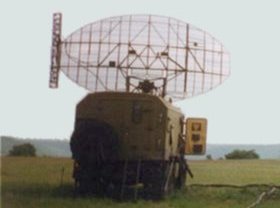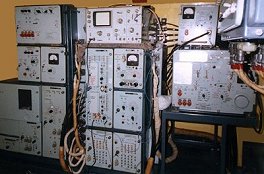Parol (1L22)
Description of the radar set, tactical-technical characteristics

Bild 1: Parol 4 mounted on a truck “Ural”
 Научно-производственное объединение
Научно-производственное объединение«Правдинский радиозавод»
| Specifications | |
|---|---|
| frequency: | UHF |
| pulse repetition time (PRT): | |
| pulse repetition frequency (PRF): | |
| pulsewidth (τ): | > 12 µs |
| receive time: | |
| dead time: | |
| peak power: | |
| average power: | |
| instrumented range: | up to 600 km |
| range resolution: | |
| accuracy: | |
| beamwidth: | |
| hits per scan: | |
| antenna rotation: | synchronous to the primary radar |
| MTBCF: | |
| MTTR: | |
Parol (Russian designator: 1L22)
This Russian secondary radar device is mainly designed for military purposes.
It is relatively immune against jamming.
It is built in 5 main versions, which are further divided into power groups.
Figure 1 shows the Parol 4 (ground-based interrogator “NRS”) with medium power mountedon a truck “Ural”.
The versions of the Parol 4 "NRS" differ electrically only by the design of the transmitter, the RF line system and the antenna.
The receivier and the decoder is the same for all versions.
This version on truck was assigned to the primary radar sets P-12, P-15, P-18, P-35 and P-37. (Some of which are presented on this homepage.) The battlefield radars got a version, that was installed into the radar electronic set. (e.g. the radar sets P-19 and P-40)
The mode of operation range from mode 1 (downward compatibility to Kremni 2) up to individual identification, and the quite comfortable mode 6, in which can also be represented in addition to the flight number the altitude of the aircraft and the fuel residue (in percent).
The parol uses three different frequencies for each interrogation cycle, one of this frequencies for the interrogation itself. The response consists of three pulses distributed over two different frequencies. The coding is realized by the distance between the first pulse and the second and the third one, and by the choice of the response frequency. Seven different response signals are possible. Thus, including the choice of the response frequency 84 different identity-numbers are possible.
Of course, the control computer of this interrogator is subject of a high category of secrecy.

Figure 2: Internal view of the electronic cabin
